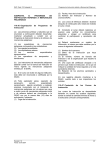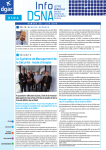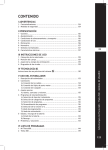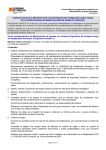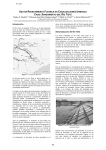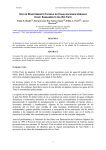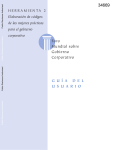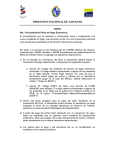Download Aeropuertos PDF (394Kb.)
Transcript
Información general General Information Aeropuertos Airports Evolución del tráfico en España. Pasajeros Durante el año 2004 el tráfico en España ha experimentado un crecimiento medio del 8%, repartido entre los diferentes aeropuertos hasta alcanzar un total de 166,1 millones de pasajeros. Los datos correspondientes a pasajeros comerciales (sin incluir tránsitos ni otros tipos de tráfico como aviación general), han tenido el mismo incremento del 8%, con un total de 164,1 millones de pasajeros. El crecimiento general de Aena ha sido durante el año 2004 superior en 1 punto al crecimiento medio en Europa y de 3 negativos respecto al total de aeropuertos de ACI1 (Airport Council International). Evolution of Air Traffic in Spain Passengers During 2004, air traffic in Spain grew by an average 8%, spread over the airports and reached a total of 166.1 million passengers. The data corresponding to commercial passengers (not including transits or other types of traffic such as general aviation) grew in the same proportion, 8%, with a total of 164.1 million passengers. The general growth of Aena in 2004 was 1 point greater than the average growth in Europe and 3 negatives with respect to the total airports of the ACI1 (Airport Council International). 18 Memoria Annual Report 2004 1 Datos de ACI Europa correspondientes a todo el año 2004 provisional y al avance de noviembre 2004 para ACI mundial. 1 Data of ACI Europe corresponding to provisional for the full year 2004 and the advance figures for 2004 for ACI worldwide. Avión en pista. Aeropuerto de Valencia Aircraft on runway at Valencia Airport Memoria Annual Report 2004 19 Aeropuertos Airports Entre todos los aeropuertos de la red, con más de un millón de pasajeros, destacan los incrementos experimentados por aeropuertos como Girona (104,5%), Reus (34,4%), Jerez (32%), Valencia (28%) y Bilbao (19,1%). Además, entre los de menor tráfico, aumentan del 35% al 222,7%, como es el caso de Albacete (222,7%), León (106,2%), Valladolid (90,4%), Logroño (89,8%) y Murcia-San Javier (52,3%). Y son importantes los crecimientos de grandes aeropuertos como MadridBarajas, Barcelona, Palma de Mallorca, Málaga y Gran Canaria que han mantenido durante el año un crecimiento del 8%, 7,9%, 6,4%, 4,1% y 3,1%, respectivamente. En el otro extremo, baja el tráfico en Vitoria (-7,1%), Zaragoza (-5,6%) y Salamanca (-4,8%). Outstanding among all the airports with over a million passengers are the increases for airports of Gerona (104.5%), Reus (34.4%), Jerez (32%), Valencia (28%) and Bilbao (19.1%). In addition, as regards those airports with less traffic, there was an increase from 35% to 222.7%, as was the case of Albacete (222.7%), León (106.2%), Valladolid (90.4%), Logroño (89.8%) and Murcia-San Javier (52.3%). There was also strong growth in the large airports such as Madrid-Barajas, Barcelona, Palma de Mallorca, Málaga and Gran Canaria, whose growth over the year was 8%, 7.9%, 6.4%, 4.1% and 3.1% respectively. At the other extreme, traffic decreased in Vitoria (-7.1%), Zaragoza (-5.6%) and Salamanca (-4.8%). Entre los aeropuertos de primer nivel, aparte de los crecimientos ya comentados, sube Alicante con un 4,6%, mientras Tenerife Sur se mantiene en niveles inferiores al año anterior. Among the first level airports, apart from the growth already mentioned, Alicante increased by 4.6%, while Tenerife Sur decreased with regard to the previous year. Siguiendo la tendencia histórica de años anteriores, los aumentos de tráfico se producen principalmente en tráfico regular, mientras que el chárter continúa retrocediendo. En cambio, en lo referente a distribución por destinos, el tráfico doméstico ha aumentado un 1,6% más que el internacional, aunque todavía sigue siendo mayoritario este último con un 59% frente al 41%. Respecto a la distribución de tráfico en regular y no regular, en este año se ha reforzado el crecimiento del tráfico regular, que alcanza el 79% del total. El reparto de tráfico entre los distintos aeropuertos de la red se mantiene en los mismos valores que años anteriores: • Los seis aeropuertos de mayor tráfico, incluyendo Alicante, suponen el 74% del tráfico comercial en España, destacando los aeropuertos de Madrid con 38,7 millones de pasajeros, Barcelona, 24,6 y Palma de Mallorca con 20,4. • Los 13 aeropuertos siguientes, con más de 1 millón de pasajeros, concentran por su parte el 22% del tráfico. • Y el resto, 25 aeropuertos, representan el 4% restante. Operaciones El número de operaciones totales durante el año 2004 en los aeropuertos españoles fue de 2,1 millones, lo que supone un 4,5% de incremento respecto a los valores de 2003. Las operaciones comerciales por su parte (sin incluir aviación general ni otras clases de tráfico) ascendieron a 1,75 millones, con un incremento del 7,3%. El crecimiento de las operaciones comerciales experimentado en los aeropuertos de Aena es superior en Following the trends of previous years, the traffic increases were mainly in regular traffic, while charter traffic continued to fall. However, as regards distribution by destination, domestic traffic increased 1.6% more than international traffic, although this continues to be greater standing at 59% as compared with 41%. As regards the distribution of traffic into regular and non-regular, the regular traffic has grown and amounts to 79% of the total. The share out of traffic among the airports of the network remains the same as in previous years. • The six airports with more traffic, including Alicante, make up 74% of the commercial traffic in Spain. Outstanding among these are Madrid with 38.7 million passengers, Barcelona with 24.6 million passengers and Palma de Mallorca with 20.4 million. • The following 13 airports, with over one million passengers, account for 22% of the traffic. • The rest, 25 airports, account for the remaining 4%. Operations The total number of operations at Spanish airports during 2004 was 2.1 million, which means an 4.5% increase with respect to the 2003 figures. The commercial operations (not including general aviation or other types of traffic) amounted to 1.75 million, an increase of 7.3%. The growth in commercial operations at Aena airports is greater by three points than that of the European Region of ACI, and by three points with regard to the total of ACI1 regions. 1 20 Memoria Annual Report 2004 Data of ACI Europe corresponding to the full provisional year 2004 and the advance for 2004 for ACI worldwide. Aeropuertos Airports The five airports with more than 100,000 operations were Madrid-Barajas (402,000), Barcelona (291,000), Palma de Mallorca (178,000), Málaga (116,000) and Gran Canaria (105,000). As regards growth, the following airports had over 25,000 movements annually, Gerona with 42.4%, Seville (14.9%), Bilbao (14.4%) and Valencia (10.9%). At the other airports with less traffic, Albacete grew 409.3%, León 66.5%, Logroño 54.5% and Valladolid 27.8%. Other airports such as Menorca (-8.8%), Vitoria (-2.7%), Salamanca (-12.6%) and Zaragoza (-12.7%) dropped in comparison with previous years. Comparatively, during 2004, operations grew less as regards passenger data, even more in the domestic market. 52% of operations at airports are domestic flights as compared with 48% international while regular flights grew 9.8% and non-regular flights decreased -4.5%. Cargo During 2004, 654,000 tons of cargo were transported. As regards commercial cargo, not including cargo in transit, 638,000 tons were transported, which means an increase of 9.9% as compared with the data of the previous year. 53% of all goods transported was concentrated in the airport of Madrid-Barajas. The total traffic is distributed between Domestic (38%) and International (62%), with greater growth in international traffic. As concerns the share out by airports, there was an increase in traffic at airports such as Barcelona (21.2%), Madrid-Barajas (11.1%), Vitoria (8.8%) and Gran Canaria (2.2%). It should also be pointed out that there was growth at San Sebastián (236.8%), Valladolid (225.3%), Seville (17.9%), Zaragoza (9.5%), Bilbao (8.9%) and Menorca (7.3%), while the average growth of other airports with substantial movements of cargo dropped, such as Tenerife Norte (-0.8%), Málaga (-0.4%), Santiago (-7.1%) and Fuerteventura (-1.5%). Opening of New Airports in 2004 It should be pointed out that a heliport was opened to commercial traffic in the Autonomous City of Ceuta. It dealt with total passenger traffic of 15,722, 1,981 operations and 8,148 kilos of cargo. tres puntos al experimentado por la Región Europea de ACI, y de cuatro puntos respecto al total de las regiones ACI1. Los cinco aeropuertos que superaron las 100.000 operaciones fueron Madrid-Barajas (402.000), Barcelona (291.000), Palma de Mallorca (178.000), Málaga (116.000) y Gran Canaria (105.000). Respecto al crecimiento, hay que señalar, con más de 25.000 movimientos anuales, Girona con un 42,4%, Sevilla (14,9%), Bilbao (14,4%) y Valencia (10,9%). En el resto de aeropuertos con menor tráfico, Albacete crece un 409,3%, León un 66,5%, Logroño un 54,5% y Valladolid un 27,8%. Otros aeropuertos como Menorca (-8,8%), Vitoria (-2,7%), Salamanca (-12,6%), o Zaragoza (-12,7%), disminuyen respecto a los valores de años anteriores. Comparativamente, las operaciones han experimentado durante 2004 un crecimiento menor a los datos de pasajeros, con mayor incidencia en el mercado nacional. El 52% de operaciones en los aeropuertos son vuelos domésticos, frente al 48% de internacional, mientras que en la distribución regular-no regular el primero crece un 9,8% y el segundo baja hasta un -4,5%. Carga Durante 2004 se transportaron 654.000 toneladas de carga total. En cuanto a carga comercial, sin incluir mercancía en tránsito, se transportaron 638.000 toneladas y supone un crecimiento del 9,9% frente a los datos del año anterior. El 53% de toda la mercancía transportada se concentra en el aeropuerto de Madrid-Barajas. El tráfico total se distribuye entre Nacional (38%) e Internacional (62%), con mayor crecimiento del tráfico internacional. Respecto al reparto por aeropuertos, se ha producido un aumento del tráfico en aeropuertos como Barcelona (21,2%), Madrid-Barajas (11,1%), Vitoria (8,8%) y Gran Canaria (2,2%). También destaca el crecimiento de San Sebastián (236,8%), Valladolid (225,3%), Sevilla (17,9%), Zaragoza (9,5%), Bilbao (8,9%) y Menorca (7,3%), mientras que otros aeropuertos con fuerte presencia de carga tienen bajada en su crecimiento medio, como Tenerife Norte (-0,8%), Málaga (-0,4%), Santiago (-7,1%) y Fuerteventura (-1,5%). Apertura de nuevos aeropuertos durante 2004 Hay que destacar la apertura al tráfico comercial de un helipuerto en la Ciudad Autónoma de Ceuta, con un tráfico de pasajeros totales de 15.772, 1.981 movimientos de operaciones y 8.148 Kg. de carga. 1 Datos de ACI Europa correspondientes a todo el año 2004 provisional y al avance de noviembre 2004 para ACI mundial. Memoria Annual Report 2004 21 Aeropuertos Airports TRÁFICO TOTAL EN AEROPUERTOS ESPAÑOLES AÑO 2004* TOTAL TRAFFIC AT SPANISH AIRPORTS 2004* Aeropuerto Pasajeros Operaciones Mercancía** Media Pax/oper A CORUÑA 586.239 12.945 539.184 45 ALBACETE 15.055 1.309 0 12 ALICANTE 120 8.571.144 71.387 6.036.750 ALMERÍA 830.930 15.046 51.138 55 ASTURIAS 943.992 14.198 420.256 66 10 BADAJOZ 82.596 8.230 0 24.558.138 291.369 84.984.845 84 3.395.773 50.361 4.152.815 67 CEUTA/HELIPUERTO 15.772 1.981 8.148 8 CÓRDOBA 19.328 8.791 0 2 EL HIERRO 144.498 4.082 172.947 35 BARCELONA BILBAO FUERTEVENTURA 3.917.109 39.865 3.639.811 98 GIRONA 2.962.988 28.668 142.973 103 GRAN CANARIA 9.467.494 104.659 40.934.830 90 590.931 13.584 85.891 44 IBIZA 4.171.580 48.798 4.510.441 85 JEREZ 1.117.447 26.599 98.300 42 30.774 3.346 3.293 9 LA PALMA 1.015.667 19.067 1.502.289 53 LANZAROTE 114 GRANADA LA GOMERA 5.517.136 48.446 7.996.939 LEÓN 65.187 5.241 33 12 LOGROÑO 38.385 2.509 8 15 38.718.614 401.503 341.176.527 96 261 66.404 0 0 25.979 11.350 18 2 12.046.277 116.047 6.811.326 104 MADRID-BARAJAS MADRID-CUATRO VIENTOS MADRID-TORREJÓN MÁLAGA MELILLA MENORCA MURCIA-SAN JAVIER PALMA DE MALLORCA PAMPLONA REUS SABADELL SALAMANCA SAN SEBASTIÁN SANTANDER 245.102 9.098 387.392 27 2.631.334 29.538 3.975.395 89 848.427 12.003 19.101 71 20.416.083 177.859 20.408.137 115 321.418 10.361 119.427 31 1.138.009 21.608 11.348 53 0 0 42.902 0 21.553 9.979 500 2 295.533 9.107 325.183 32 29 342.559 11.643 27.274 SANTIAGO 1.580.675 21.593 4.938.613 73 SEVILLA 2.678.595 44.231 5.053.487 61 TENERIFE NORTE 3.368.988 56.592 23.647.190 60 TENERIFE SUR 8.632.178 62.824 9.218.052 137 VALENCIA 3.111.951 72.679 12.169.271 43 VALLADOLID 442.218 11.386 678.217 39 VIGO 911.974 15.458 1.029.729 59 95.094 12.927 43.683.433 7 215.213 9.386 9.160.282 23 166.146.198 2.056.959 638.120.793 81 VITORIA ZARAGOZA TOTAL * Incluidos tránsitos y otras clases de tráficos. ** Los datos de Kg. mercancía no incluyen Otras Clases de Tráfico ni Mercancía en Tránsito. También pertenece a la red de Aena el Aeropuerto de Palma - Son Bonet. Los Aeropuertos de Burgos y de Monflorite-Alcalá (Huesca) han sido declarados de interés general y Aena está llevando a cabo en ellos diversas actuaciones para su apertura al tráfico civil. * including transits and other types of traffic. ** The data on kilos of goods coes not include Other Types of Traffic or Goods in Transit. The airport of Palma – San Bonet also belongs to the Aena network. The airports of Burgos and Monflorite-Alcalá (Huesca) have been declared of general interest and Aena is carrying out work to open these up to civil traffic. 22 Memoria Annual Report 2004 Aeropuertos Airports TRÁFICO EN LOS AEROPUERTOS ESPAÑOLES DURANTE EL AÑO 2004* TRAFFIC AT SPANISH AIRPORTS DURING 2004* 2004 %Inc 2004/2003 %Tráfico AERONAVES Nacional 911.233 7,7% Internacional 837.609 6,8% 41% Otras Clases 308.117 -9% 15% 2.056.959 4,5% 100% Nacional 68.509.068 8,9% 41% Internacional 95.593.836 7,4% 58% Otras Clases 286.451 11,8% 0% 1.756.843 10,2% 1% 166.146.198 8% 100% TOTAL 44% PASAJEROS Tránsitos TOTAL KG. MERCANCÍAS Nacional 243.628.457 6,1% 37% Internacional 394.492.336 12,4% 60% Otras Clases 251.614 -22,5% 0% 15.627.331 -33,4% 2% 653.999.738 1,4% 100% Nacional 70.945.353 8,8% 41% Internacional 99.538.759 7,5% 58% Otras Clases 288.967 11,4% 0% 1.913.116 4,6% 1% 172.686.195 8% 100% Tránsitos TOTAL UNIDADES DE TRÁFICO** Tránsitos TOTAL * Datos totales incluyendo tránsitos y otras clases de tráfico. ** Las Unidades de Tráfico equivalen a un pasajero y su equipaje o 100 Kg. de carga. * Total data including transit and other types of traffic. ** Units of traffic are the equivalent of one passenger and his baggage or 100 kilos of cargo. Memoria Annual Report 2004 23 Aeropuertos Airports AEROPUERTOS CON MAYOR NÚMERO DE PASAJEROS TOTALES DURANTE EL AÑO 2004 (MILLONES) PASAJEROS TOTALES 2004 TOTAL PASSENGERS Aeropuertos MADRID-BARAJAS AIRPORTS WITH A GREATER NUMBER OF PASSENGERS DURING 2004 Pax 38.718.614 BARCELONA 24.558.138 PALMA DE MALLORCA 20.416.083 MÁLAGA 12.046.277 GRAN CANARIA 9.467.494 TENERIFE SUR 8.632.178 ALICANTE 8.571.144 LANZAROTE 5.517.136 IBIZA 4.171.580 FUERTEVENTURA 3.917.109 BILBAO 3.395.773 TENERIFE NORTE 3.368.988 VALENCIA 3.111.951 GIRONA 2.962.988 SEVILLA 2.678.595 MENORCA 2.631.334 SANTIAGO 1.580.675 REUS 1.138.009 JEREZ 1.117.447 LA PALMA 1.015.667 ASTURIAS 943.992 VIGO 911.974 MURCIA-SAN JAVIER 848.427 ALMERÍA 830.930 GRANADA 590.931 A CORUÑA 586.239 VALLADOLID 442.218 SANTANDER 342.559 PAMPLONA 321.418 SAN SEBASTIÁN 295.533 MELILLA 245.102 ZARAGOZA 215.213 EL HIERRO 144.498 VITORIA 95.094 BADAJOZ 82.596 LEÓN 65.187 LOGROÑO 38.385 LA GOMERA 30.774 MADRID-TORREJÓN 25.979 SALAMANCA 21.553 CÓRDOBA 19.328 CEUTA/HELIPUERTO 15.772 ALBACETE 15.055 MADRID-CUATRO VIENTOS SABADELL TOTAL LA PALMA JEREZ REUS SANTIAGO MENORCA SEVILLA GIRONA VALENCIA TENERIFE NORTE BILBAO FUERTEVENTURA IBIZA LANZAROTE ALICANTE TENERIFE SUR GRAN CANARIA MÁLAGA PALMA DE MALLORCA BARCELONA 261 0 MADRID-BARAJAS 166.146.198 0 24 Memoria Annual Report 2004 5 10 15 20 25 30 35 40 Aeropuertos Airports TRÁFICO AÉREO DE PASAJEROS TOTALES DEL AÑO 2004* TOTAL PASSENGER AIR TRAFFIC DURING 2004* 2004 %Inc 2004/2003 % Tráfico REGULAR Nacional 65.566.398 8,7% Internacional 65.384.904 13,1% 50% 130.951.302 12,3% 100% TOTAL 50% CHARTER 2.930.938 13,1% 9% Internacional Nacional 30.197.281 7,8% 91% TOTAL 33.128.219 -6,2% 100% OTROS SERVICIOS 23.382 -17% 0% 286.452 11,8% 0% 1.756.843 10,2% 1% 166.146.198 8% 100% OTRAS CLASES TRÁFICO TRÁNSITO TOTAL * Pasajeros totales incluyendo tránsitos y Otras Clases de Tráfico. * Total passengers including transit and other types of traffic. EVOLUCIÓN DEL TRÁFICO DE PASAJEROS 1995-2004 EVOLUTION OF PASSENGER TRAFFIC 1995-2004 143.092.601 1996 144.600.598 1995 140.997.305 40.000.000 119.024.523 60.000.000 103.554.386 80.000.000 97.933.667 100.000.000 111.331.125 120.000.000 128.891.671 140.000.000 2000 2001 2002 153.826.341 160.000.000 166.146.198 180.000.000 20.000.000 0 1997 1998 1999 2003 2004 Memoria Annual Report 2004 25 Aeropuertos Airports PASAJEROS PASSENGERS COMERCIAL NACIONAL REGULAR NO REGULAR TRÁNSITOS 1997 43.782.549 2.638.224 30.974.879 31.392.863 239.219 2.303.391 1998 45.269.075 2.473.072 35.727.908 33.321.003 282.040 1.951.425 1999 48.668.536 2.410.194 40.330.558 35.396.521 265.272 1.820.590 2000 55.979.285 1.875.832 45.781.831 35.401.016 298.517 1.660.824 2001 57.883.172 1.655.429 49.185.247 34.143.728 230.476 1.479.352 2002 55.857.853 2.261.547 49.773.812 33.386.752 288.783 1.500.565 2003 60.325.919 2.590.053 56.291.001 32.740.373 256.261 1.594.577 2004 65.566.398 2.930.938 65.384.904 30.197.281 286.452 1.756.843 PASAJEROS COMERCIALES NACIONALES PASAJEROS COMERCIALES INTERNACIONALES DOMESTIC COMMERCIAL PASSENGERS INTERNATIONAL COMMERCIAL PASSENGERS 70.000.000 70.000.000 60.000.000 60.000.000 50.000.000 50.000.000 40.000.000 40.000.000 30.000.000 30.000.000 20.000.000 20.000.000 10.000.000 10.000.000 0 0 1997 1998 1999 Regular 2000 2001 2002 2003 2004 1997 No Regular 1998 1999 Regular 2000 2001 2002 2003 2004 No Regular DISTRIBUCIÓN PASAJEROS TOTALES AÑO 2004 DISTRIBUCIÓN DEL TRÁFICO DE PASAJEROS TOTALES AÑO 2004 DISTRIBUTION TOTAL NUMBER OF PASSENGERS 2004 DISTRIBUTION OF TRAFFIC OF TOTAL NUMBER OF PASSENGERS 2004 REG. NAC. NO REG. NAC. 65.566.398 65.384.904 NO REG. INT. 30.197.281 TRÁNSITOS TOTAL OTROS SERVICIOS NO INCLUIDOS TOTAL NO REG. INT. 18,18% 2.930.938 REG. INT. OTRAS CLASES REG. INT. 39,36% 286.452 Memoria Annual Report 2004 OTRAS CLASES 0,17% TRÁNSITOS 1,06% 1.756.843 166.122.816 23.382 166.146.198 NO REG. NAC. 1,76% 26 OTRAS CLASES INTERNACIONAL REGULAR NO REGULAR REG. NAC. 39,47% Aeropuertos Airports TRÁFICO AÉREO DE AERONAVES DEL AÑO 2004* AIRCRAFT TRAFFIC DURING 2004* 2004 %Inc 2004/2003 % Tráfico REGULAR Nacional 820.218 8,6% Internacional 617.509 11,3% 43% 1.437.727 9,8% 100% 26% TOTAL 57% CHARTER Nacional 72.231 -1,6% Internacional 206.063 -5,5% 74% TOTAL 278.294 -4,5% 100% OTROS SERVICIOS 32.821 13,4% 1% 308.117 -9% 15% 2.056.959 4,5% 100% OTRAS CLASES TRÁFICO TOTAL * Operaciones totales incluyendo Otras Clases de Tráfico. * Total operations including other types of traffic. EVOLUCIÓN DEL TRÁFICO TOTAL DE AERONAVES 1995-2004 (EN MILES) EVOLUTION OF TOTAL AIRCRAFT TRAFFIC 1995-2004 (IN THOUSANDS) 2.200 2001 2002 2.056 1.894 2000 1.969 1.902 1.543 1.350 1.000 1.256 1.400 1.200 1.464 1.600 1.685 1.800 1.854 2.000 2003 2004 800 600 0 1995 1996 1997 1998 1999 Memoria Annual Report 2004 27 Aeropuertos Airports TRÁFICO AÉREO DE MERCANCÍAS DEL AÑO 2004 (Kgs.)* AIR TRAFFIC OF GOODS DURING 2004 (Kilos)* 2004 %Inc 2004/2003 % Tráfico 38% REGULAR Nacional 185.482.029 4,2% Internacional 302.033.616 14,6% 62% TOTAL 487.515.645 10,4% 100% Nacional 57.002.690 12,7% 38% Internacional 92.344.115 5,9% 62% 149.346.805 8,4% 100% CHARTER TOTAL OTROS SERVICIOS 1.258.343 0,9% 0% 251.614 -7,9% 0% 15.627.331 -33,4% 2% 653.999.738 1,4% 100% OTRAS CLASES TRÁFICO TRÁNSITO TOTAL * Mercancías totales incluyendo tránsitos y Otras Clases de Tráfico. * Total goods including transit and other types of traffic. EVOLUCIÓN DEL TRÁFICO TOTAL DE MERCANCÍAS 1995-2004 EVOLUTION OF TOTAL TRAFFIC OF GOODS 1995-2004 900 800 605 2001 2002 2003 654 596 1998 601 1997 608 559 501 455 400 550 600 500 638 700 300 200 100 0 1995 1996 1999 2000 2004 Miles Toneladas Thousands of tons 28 Memoria Annual Report 2004 Aeropuertos Airports TRÁFICO EN AEROPUERTOS EUROPEOS EN 2004* TRAFFIC AT EUROPEAN AIRPORTS IN 2004* Aeropuertos Total Pasajeros % Incremento LONDON (HEATHROW) 67.343,960 6,07 FRANKFURT 51.098,271 5,68 PARÍS (CHARLES DE GAULLE) 50.860,561 5,48 AMSTERDAM 42.541,180 6,46 MADRID-BARAJAS 38.718,614 8,00 LONDON (GATWICK) 31.461,523 4,85 ROME 28.118,562 6,98 MUNICH 26.814,505 10,83 BARCELONA 24.558,138 7,92 PARÍS (ORLY) 24.032,211 7,01 MANCHESTER 21.548,454 8,34 LONDON (STANSTED) 20.908,089 11,71 PALMA DE MALLORCA 20.416,083 6,42 COPENHAGEN 18.965,675 7,49 MILÁN (MALPENSA) 18.553,953 5,29 ZURICH 17.214,501 1,32 DUBLÍN 17.138,373 8,09 STOCKHOLM 16.362,498 7,60 BRUSSELS 15.583,735 2,77 DUSSELDORF 15.256,506 6,87 OSLO 14.865,460 8,93 VIENNA 14.785,529 15,65 ATHENS 13.640,581 12,03 MÁLAGA 12.046,277 4,12 BERLÍN 11.047,954 -0,51 LISBON 10.705,149 11,09 HELSINKI 10.671,445 9,92 GRAN CANARIA 9.467,494 3,10 NICE 9.334,525 2,11 MILÁN (LINATE) 8.947,915 2,18 TENERIFE SUR 8.632,178 -2,50 * Media de crecimiento en Europa 7,01% * Average growth in Europe 7.01% Memoria Annual Report 2004 29 Aeropuertos Airports Servicios aeroportuarios Airport Services Durante el pasado año se puso en funcionamiento el Servicio de Información y Atención Telefónica de Aena (902.404.704) y se ha iniciado el proceso para la integración con el Centro de Llamadas de Madrid-Barajas que culminará con un nuevo servicio dotado de nuevas funcionalidades cuyo proceso de selección se ha iniciado también en este año 2004. During last year, the Aena Telephone Attention and Information Service (902 404 704) came into service and the process for integration with the Madrid-Barajas Call Centre began, and this will culminate wit a new service with new functionalities, whose selection process also commenced in 2004. También finalizó el proceso de elaboración de los Pliegos de Cláusulas de Explotación que regirán las concesiones de los servicios aeroportuarios de asistencia en tierra en las categorías de servicios de rampa. Estos pliegos se utilizarán como base para el proceso de licitación pública que se iniciará en el año 2005. En el mismo área se ha culminado la primera fase de la implantación del Manual de los Servicios de Asistencia en Tierra, orientado a la definición de los niveles de calidad que deben conseguirse en esta actividad. Asimismo se elaboraron, editado y difundido el Anuario Estadístico de Operaciones de 2003, en formato papel y CD y las dos ediciones previstas, mayo y octubre, de los “Estudios de Tráfico” para todos los aeropuertos de la red, que contiene un análisis del tráfico esperado a corto plazo. Sistemas de información 30 The drafting process for the Operating Specifications which will govern the concession of airport ground assistance services as regards the ramp services category also finalised. These specifications will be used as a basis for the public tender process which will begin in 2005. In this same area, the first phase of the implementation of the Ground Assistance Services Manual was completed. This is oriented towards the definition of the quality levels which must be achieved in this activity. In addition, the 2003 Yearbook on Operations Statistics was drawn up, edited and published on a paper and CD format. Also published were the two editions of “Traffic Studies” for all the airports of the network planned for May and October, containing an analysis of the traffic expected in the short term. Information Systems En el ámbito de Sistemas de Información se han completado los desarrollos e infraestructuras básicas del nuevo terminal de Madrid-Barajas, e iniciado el despliegue y pruebas de la solución técnica en el aeropuerto piloto de Gran Canaria. Por el número de participantes y complejidad técnica, el Centro de Proceso de Datos y la dotación del Centro de Gestión Aeroportuaria con la integración de más de 100 puestos de trabajo, sistemas y dispositivos de presentación, han sido los proyectos más costosos. Por su parte, la Red Multiservicio ha completado y puesto en servicio la instalación troncal y durante los próximos meses completará el cableado a los puntos de usuario final. In the area of information systems, the development and the basic infrastructure of the new Madrid-Barajas Terminal was completed, and the deployment and trials for the technical solutions to the pilot airport of Gran Canaria were initiated. The Data Processing Centre and the resources for the Airport management Centre with the integration of over 100 jobs, systems and presentation devices were the most costly projects due to the number of persons involved and the technical complexity. The Multi-Service Network completed and commissioned the core installation and, over the next few months, it will complete the cabling to the final user points. Igualmente, se inició la instalación del hardware y software base en los aeropuertos de primer y segundo nivel y centralizada para el resto de aeropuertos. El objetivo es cambiar las aplicaciones del entorno operacional de todos los aeropuertos de Aena en un programa de instalaciones a dos años, que permita la integración de datos en un middleware aeroportuario, con acceso de los usuarios tanto internos como externos. Moreover, the installation of the hardware and software base began at the first and second level airports and will be centralised for the others. The goal is to change the applications of the operational environment at all the Aena airports in an installations programme in two years. This will make it possible to integrate data in an airport middleware which can be accessed by both internal and external users. En el ámbito de explotación y control de calidad, siguiendo la metodología y buenas prácticas ITIL, se puso en marcha el In the area of operations and quality control, following the ITIL best practice and methodology, Memoria Annual Report 2004 Aeropuertos Airports an office machines 24 hour Service Desk came into service for the airport systems with a view to making progress in the integration of calls and monitoring the availability and performance of the systems. Furthermore, the processes for the definition and trials of the applications and the functioning of the laboratory for the approval of products were consolidated. Apart from the tests on the applications to be installed at the pilot airport in Gran Canaria, the more representative work carried out in this laboratory was on the flight information equipment for the new Barajas terminal and the definition of the new security development, CCTV and access control, which are planned to come into production at the new terminal in Barcelona. As regards networks and communications, the tender for the liberalisation of the data transport services, mobile and fixed telephony was published, and is forecast to be executed in the course of next year. The tender for the installation of the Multi-Service Network of the new terminal and airport environment of Barcelona was also adjudicated. This has high capacity Ethernet trunks and separation of traffic in 3 planes with different criticalities and services and will constitute the most modern infrastructure addressed by Aena up to now. Service Desk de ofimática y soporte H24 para los sistemas aeroportuarios, avanzando en la integración de llamadas y monitorizado de la disponibilidad y rendimiento de los sistemas. Asimismo, se han consolidado los procesos de definición y pruebas de aplicaciones y el funcionamiento del laboratorio de homologación de productos. Los trabajos más representativos en este laboratorio, aparte de las pruebas de aplicaciones a instalar en el piloto de Gran Canaria, han sido las relativas al equipamiento de información de vuelos del nuevo terminal de Barajas y la definición del nuevo desarrollo de seguridad, CCTV y control de accesos que está previsto poner en producción en el nuevo terminal de Barcelona. En redes y comunicaciones se publicó el concurso de liberalización de los servicios de transporte de datos, telefonía móvil y fija, que previsiblemente entrará en ejecución durante el próximo año. También se ha adjudicado el expediente para la instalación de la red Multiservicio del nuevo terminal y entorno aeroportuario de Barcelona, que con troncales Ethernet de muy alta capacidad y separación de tráfico en 3 planos de distinta criticidad y prestaciones, será la infraestructura más moderna planteada hasta ahora en Aena. Operaciones Operations With regard to operational security, the process for the certifications of aerodromes continues with the drafting and implementation of an Aerodrome Manual, a pilot in the airport of Ibiza and the first phase at the airports of MadridBarajas, Barcelona, Tenerife Sur and Palma de Mallorca. In addition, a draft was made of the updating of the Operational Safety Regulations. A survey was made of the ICAO Universal Safety Oversight Audit Programme. Work was carried out to draft and implement the Management Plan for Spanish Airports for the application of the European Action Plan for the Prevention of Runway Incursions (EAPPRI) and for the definition of an Operational Safety Management System. Moreover, operational instructions were drafted, outstanding among which are the following: work previous to the commencement of the operational schedule, work concerning the declaration of an operational airport , regulations applicable in the event of incidences in the visual aid systems and the meteorological equipment, and the adaptation of the Aerodrome Warning Bulletins. As regards the programme for the determination of obstacles in approach, take off and taxiing areas, studies were made in the airports of A Coruña, Alicante, Barcelona, Menorca and Santander. En lo referente a la seguridad operacional, continúa el proceso de certificación de aeródromos, con la elaboración e implantación de un Manual de Aeródromo, un piloto en el aeropuerto de Ibiza y la 1ª fase de elaboración en los aeropuertos de Madrid-Barajas, Barcelona, Tenerife Sur y Palma de Mallorca. Además, se elaboró un borrador de la actualización de la Normativa de Seguridad Operacional. Se completó la encuesta del Programa Universal OACI de Auditoría de la Vigilancia de la Seguridad Operacional (USOAP). Se trabajó en la elaboración e implantación del Plan de la Dirección de Aeropuertos Españoles para la aplicación del Plan Europeo para la Prevención de Incursiones en Pista (EAPPRI) y en la definición de un Sistema de Gestión de la Seguridad Operacional (SGSO). También se redactaron diversas instrucciones operativas entre las que destacan: actuaciones previas al inicio del horario operativo, actuaciones para la declaración de aeropuerto operativo, normas aplicables en caso de incidencias en los sistemas de ayudas visuales y equipamiento meteorológico y la adecuación de la de Boletines de Avisos de Aeródromo. En cuanto al programa de determinación de obstáculos en las áreas de aproximación, despegue y circuito, se realizaron estudios de los aeropuertos de A Coruña, Alicante, Barcelona, Menorca y Santander. Memoria Annual Report 2004 31 Aeropuertos Airports Igualmente se realizó una nueva edición del Manual Técnico para la Accesibilidad en los Aeropuertos Españoles y los Manuales de Autoprotección de los aeropuertos de Burgos, Santiago, Ibiza, Valladolid, Santander, Monflorite-Alcalá (Huesca), resto de edificios de Bilbao, Badajoz, Reus y Sevilla. Y se realizó el asesoramiento en su implantación en los aeropuertos de: Reus, Ibiza, Santiago, Gran Canaria, Tenerife Sur, Murcia-San Javier, Alicante y Tenerife Norte. A new edition of the Technical Manual for Accessibility in Spanish Airports was also drafted together with the Self-Protection Manuals for the airports of Burgos, Santiago, Ibiza, Valladolid, Santander, Monflorite-Alcalá (Huesca), the rest of the buildings at Bilbao, Badajoz, Reus and Seville. An assessment was also carried out as regards its implementation in the airports of Reus, Ibiza, Santiago, Gran Canaria, Tenerife Sur, Murcia-San Javier, Alicante and Tenerife Norte. Con el desarrollo de un nuevo modelo paramétrico con WITNESS para realizar cálculos de capacidad en las zonas de llegadas y plataforma, se han realizado estudios de capacidad de Edificio Terminal en los aeropuertos de Lanzarote, Gran Canaria, Tenerife Sur, Madrid (T1, T2, T3 y T4), Asturias, Bilbao, Jerez, Murcia y Fuerteventura. También se colaboró en el diseño funcional del aeropuerto de Reus. Además, se han elaborado estudios para el desarrollo de infraestructuras para la aviación de negocios en el área de Madrid, Barcelona, Málaga y Palma de Mallorca. With the development of a new parametric model with WITNESS in order to make calculations of capacity in the arrival and platform areas, Terminal Building capacity studies were made at the airports of Lanzarote, Gran Canaria, Tenerife Sur, Madrid (T1, T2, T3 and T4), Asturias, Bilbao, Jerez, Murcia and Fuerteventura. Collaboration was also provided for the functional design of Reus airport. In addition, studies were made for the development of infrastructures for business aviation in the areas of Madrid, Barcelona, Málaga and Palma de Mallorca. Calidad de Servicios Service Quality En Calidad de Servicios se trabaja en la implantación de Sistemas de Gestión Ambiental (SGA) y Sistemas de Gestión de Calidad (SGC), así como en tareas relativas a los Niveles de Calidad Percibida (NCP) y de los Ecosistemas, en los distintos aeropuertos y en la propia Dirección de Aeropuertos. As regards service quality, work is being carried out on the implementation of Environmental management Systems and Quality Management System , as well as work on the levels of Perceived Quality and on the Ecosystems at the airports and at the management offices of Aena. Se realizaron encuestas de Niveles de Calidad Percibida, denominadas encuestas AEQual, en 41 aeropuertos de la red con tráfico de pasajeros y sus acompañantes, y se elaboran los correspondientes Informes Generales con periodicidad trimestral y anual. Surveys were made on the Levels of Perceived Quality, called AEQual, at 41 airports of the network with passenger traffic and those accompanying passengers. The relevant General Reports are drawn up quarterly and annually. Otros informes anuales relacionados con la calidad percibida son: “Informe del Compromiso de los Aeropuertos de Aena con los Pasajeros”, “Informe de Calidad Percibida de las Compañías Aéreas” e “Informe de Quejas y Reclamaciones en los Aeropuertos Españoles”. Centro de Gestión de Red H-24 Comenzaron a funcionar las instalaciones situadas en el aeropuerto de Barajas, que incluyen una sala de operaciones, una sala de crisis y el conjunto de herramientas informáticas y audiovisuales que son manejadas en el centro. 32 Memoria Annual Report 2004 Other annual reports related to perceived quality are the following: “Report on the Commitment of the Aena Airports with the Passengers”, “Report on the Perceived Quality of the Airlines” and the “Report on Complaints and Claims at Spanish Airports”. H-24 Network Centre management The installations at Barajas Airport began to function. These included an operations room, a crisis room and the computer and audiovisual tools used at the centre. Aeropuerto de Alicante Alicante Airport Among the computer tools, we should point out the Incidence Management System, which makes it possible to have an updated database of all the incidences which occur in the Aena Network and the Flight Progression System, which permits real time awareness and the making of a prognosis as regards the situation of each of the flights managed by Aena. The information handled by the CGR H-24 enables each airport and air navigation centre to know the operational situation in the rest of the network. Moreover, this information is at the disposal of the Aena Crisis Committee in order to optimise the management of crisis situations. Central Airport Safety Office Aena has participated in the work groups set up by the National Safety Committee for the review and updating of the National Safety Programme for Civil Aviation, the updating of the National Programme for Quality in Civil Aviation Safety and the drawing up of the National Programme De entre las herramientas informáticas destacan el Sistema de Gestión de Incidencias, que permite disponer de una base de datos actualizada de todas las incidencias que tienen lugar en la Red de Aena y el Sistema de Progresión de Vuelos, que permite conocer en tiempo real (y llevar a cabo prognosis), sobre la situación de cada uno de los vuelos gestionados por Aena. La información manejada por el CGR H-24 permite a cada uno de los aeropuertos y centros de navegación aérea conocer la situación operativa en el resto de la Red. Además, dicha información es puesta a disposición del Comité de Crisis de Aena con el fin de optimizar la gestión de situaciones de crisis. Oficina central de seguridad aeroportuaria Aena ha participado en los grupos de trabajo creados por el Comité Nacional de Seguridad para la revisión y actualización del Programa Nacional de Seguridad para la Aviación Civil, la actualización del Programa Nacional de Calidad de la Seguridad de la Aviación Civil y la elaboración del Programa Nacional de Memoria Annual Report 2004 33 Aeropuertos Airports Formación de Seguridad de la Aviación Civil, aprobado este último el 7 de julio de 2004. Asimismo, Aena ha contribuido con sus comentarios a la elaboración del borrador de “Proyecto de Acuerdo de Consejo de Ministros por el que se aprueba el Programa Nacional de Seguridad de la Aviación Civil” y el borrador de “Proyecto de Real Decreto por el que se designa la autoridad competente en materia de seguridad de la aviación civil y se determina la organización y funciones del Comité Nacional de Seguridad de la Aviación Civil”. Durante el año 2004, la Dirección General de Aviación Civil ha realizado 13 auditorías de seguridad en nuestros aeropuertos, en algunas de las cuales ha participado personal de la Oficina Central de Seguridad Aeroportuaria, como auditores cualificados por la autoridad competente. Durante este año se ha adjudicado un nuevo expediente de contratación de vigilancia privada para 22 aeropuertos, con la particularidad de tener plazos comunes y pudiendo las empresas optar por prestar el servicio de forma individual. Se está trabajando en aplicación de las nuevas tecnologías IP enfocado a la definición de requisitos técnicos y funcionales para la gestión de la video vigilancia por IP y se han realizado pruebas en el aeropuerto de Córdoba. for Safety Training for Civil Aviation approved on July 7, 2004. In addition, Aena has contributed with its comments to the drawing up of the draft of the “Project Agreement of the Council of Ministers whereby the National Safety Programme for Civil Aviation is approved” and the draft of the “Royal Decree Project whereby the competent authority as regards civil aviation safety is designated and the organisation and functions of the National Committee of Civil Aviation Safety is determined. During 2004, the Department of Civil Aviation carried out 13 safety audits at our airports, and staff from the Central Office for Airport Safety participated in some of these audits as auditors qualified by the competent authority. During the year, another tender for private surveillance at 22 airports was adjudicated. This was special as there were common places and the companies could choose to provide the service individually. Work is being done as regards the application of new IP technologies focussed on the definition of technical and functional requisites as regards the management of surveillance video by IP and trials have been carried out at Córdoba airport. Coordination of Airport Slots Coordinación de slots aeroportuarios Durante el año 2004, Coordinación de Slots Aeroportuarios ha realizado las actividades de coordinación de los slots aeroportuarios y seguimiento de los mismos, correspondientes al final de la temporada de invierno 03 y a las temporadas de verano 04, Invierno 04 y Verano 05 en todos aquellos aeropuertos españoles declarados como Facilitados o Coordinados. Además, de estas dos últimas temporadas de Invierno 04 y Verano 05, se efectuó la coordinación inicial de acuerdo a las solicitudes de demanda inicial recibida de las compañías aéreas y a las capacidades aeroportuarias declaradas, y se celebraron dos Conferencias Mundiales de Coordinación de Horarios en Toronto (Canadá) y Boston (Estados Unidos) en junio y noviembre, respectivamente. También esta División estuvo representada en la reunión para el intercambio de slots (swaps) y mejora de las programaciones de las compañías aéreas que se celebró en el mes de febrero en París y que fue organizada por la Asociación Europea de Coordinadores de Slots Aeroportuarios (EUACA) con el propósito de aliviar los problemas de congestión en los aeropuertos y 34 Memoria Annual Report 2004 During 2004, Coordination of Airport Slots has coordinated and monitored the airport slots corresponding ton the end of the 2003 winter season and the 2004 summer season, the 2004 winter season and the 205 summer season at all the Spanish airports declared to be Facilitated or Coordinated. Besides these last tow winter 2004 and summer 2005 seasons, the initial coordination was carried out in accord with the initial petitions received from the airlines and the declared airport capacities. Two World Schedule Coordination Conferences were also held in Toronto (Canada) and Boston (United States) in June AND November respectively. This division was also represented at the meeting for the swapping of slots and the improvement of schedules of the airlines which was held in February in Paris and was organised by the European Union Airport Coordinators Association (EUACA) in order to alleviate the congestion at airports and adjust the scheduling of the airlines for the 2004 summer season. Aeropuertos Airports Finally, in 2004, the feasibility studies corresponding to the proposals for the modification of the operational schedules at several airports were initiated or continued. As a result of these studies, the schedules of the airports of Albacete, Asturias, Bilbao, Gerona, Granada, León, Reus and Seville were modified in order to adapt them to the existing operational demand. International Relations Airport Marketing and During 2004, international activity was intense as important legislative initiatives were adopted and there were major changes in the air travel sector. There were innovations in many areas. As concerns the rights of the passengers, there was the adoption of Regulation 261/2004 on Compensation due to Refusal to Board, Cancellation or Serious Delay to Flights. This regulation involves the application of a number of measures to alleviate the effect of these occurrences on passengers and to prevent them being left unattended at European airports. The Management of Spanish Airports participated through the European Policy Committee of ACI EUROPE in its legislative processing where it communicated the opinion of the airports to the European institutions. There were also major changes in the process for assigning schedule bands: Regulation 793/2004 came into force in July and established new norms as regards the assigning of slots and subsequently a consultation document was published by the Commission on the possible market mechanisms for the assigning of schedule bands. In relation to this last point, the Management of Spanish Airports developed and defended its position as an airport manager and slot coordinator and submitted this to the domestic and European institutions. The most important environmental debate at international level was centred on the possible extension of the system for the trading of issue rights to the air traffic sector. The Management of Spanish Airports appointed an expert in the Working Group on Issues of ACI Europe and collaborated with the national authorities in the study on the feasibility of this proposal. ajustar las programaciones de las compañías correspondientes a la temporada de verano 04. Finalmente, en el año 2004 se iniciaron o continuaron los estudios de viabilidad correspondientes a las propuestas de modificación de los horarios operativos de varios aeropuertos. Como resultado de dichos estudios, se han modificado los horarios de los aeropuertos de Albacete, Asturias, Bilbao, Girona, Granada, León, Reus y Sevilla, a fin de adaptarlos a la demanda de operación existente. Relaciones internacionales aeroportuario y marketing La actividad internacional durante el año 2004 ha sido muy intensa, al adoptarse importantes iniciativas legislativas y producirse serios cambios en el sector aéreo. Han sido muchas las áreas en las que han surgido novedades. En materia de derechos de los pasajeros, es preciso señalar la adopción del Reglamento 261/2004 sobre Compensación por Denegación de Embarque, Cancelación o Gran Retraso de los Vuelos. Este Reglamento impone la aplicación de una serie de medidas para paliar los efectos de estos eventos sobre los pasajeros y evitar que permanezcan desatendidos en los aeropuertos europeos. La Dirección de Aeropuertos Españoles participó, a través del Comité de Política Europea de ACI EUROPA, en su tramitación legislativa, haciendo llegar a las instituciones europeas la opinión de los aeropuertos. Por otra parte, se han producido grandes cambios en el proceso de asignación de franjas horarias: en julio entró en vigor el Reglamento 793/2004 que establece nuevas normas sobre asignación de slots y posteriormente se publicó un documento de consulta de la Comisión sobre posibles mecanismos de mercado en la asignación de franjas horarias. En relación con este último punto, la Dirección de Aeropuertos Españoles desarrolló y defendió su postura, como gestor aeroportuario y como coordinador de slots, que presentó ante las instituciones nacionales y europeas. El debate medioambiental más importante a nivel internacional ha estado centrado en la posible extensión del sistema de comercio de derechos de emisión al sector aéreo. La Dirección de Aeropuertos Españoles ha nombrado a un experto en el Grupo de Trabajo sobre Emisiones de ACI EUROPA y ha colaborado con las autoridades nacionales en el estudio de la viabilidad de esta propuesta. Memoria Annual Report 2004 35 Helipuerto de Ceuta Ceuta Heliport En relación con la negociación entre la Comisión Europea y EE.UU. para la creación de un Área Trasatlántica Común, a pesar de que el acuerdo preliminar propuesto al Consejo Europeo fue rechazado en junio, la industria aeroportuaria y especialmente la Dirección de Aeropuertos Españoles defendieron la trascendencia de la liberalización de los derechos de tráfico internacionales. El año 2004 también ha sido clave para el inicio de la reestructuración del sector aéreo. En el mes de febrero el Ejecutivo comunitario dictó una resolución declarando ilegales ciertas ayudas concedidas por el aeropuerto de Charleroi y la región de Walonia a la compañía de bajo coste Ryanair. La resolución contenía una pauta concreta para la concesión de estas ayudas y, en cierto modo, reconocía esta práctica. La Dirección de Aeropuertos Españoles, a través del Comité de Política Europea, participó en el debate sobre los nuevos clientes, las aerolíneas de bajo coste y sus efectos en los aeropuertos. Además del reconocimiento de este nuevo fenómeno por parte de la Comisión, se han producido importantes cambios que están transformando el sector (la fusión entre Air France y KLM, la crisis de Alitalia, la desaparición de compañías y touroperadores...). A este panorama se une la adhesión, en el mes de mayo, de 15 nuevos socios a la Unión 36 Memoria Annual Report 2004 As regards the negotiations between the European Commission and the United States for the creation of a Common Transatlantic Area, despite the fact that the preliminary agreement proposed to the European Council was rejected in June, the airport industry, and the Management of Spanish Airports in particular, defended the importance of the liberalisation of international traffic rights. 2004 was a key year as regards the initiation of the restructuring of the air traffic sector. In February, the Community Executive dictated a resolution declaring certain aid granted by the airport of Charleroi and the Walloon region to the low cost airline, Ryanair, to be illegal. The resolution contained a specific guideline for the concession of these aids and, to a certain extent, recognised this practice. Through the European Policy Committee, the Management of Spanish Airports participated in the debate on new customers, low cost airlines and their effect on the airports. In addition to the Commission recognising this new phenomenon, substantial changes are transforming the sector such as the merger of Air France and KLM, the crisis of Alitalia, the disappearance of companies and tour operators. This panorama also includes the incorporation of Aeropuertos Airports 15 new countries to the European Union on May 15, together with their airlines, their potential routes and their emerging markets. The International Relations Division and Airport Marketing have studied and evaluated this new situation in order to provide an attractive airport product. The 10th Forum on Route Development was held in Madrid in September 2004, with Aena as the host of this single prestigious event, meant the culmination of a process for the identification of new business opportunities initiated in September 2003. During 2004, 16 Product-Airport Definitions were made and profiles of 105 potential routes were made. After the study and evaluation of the business opportunities detected, an analysis was made of the existing and potential clients in disposition to operate the route, taking into account the criteria of the market of origin, the expansion strategy, etc., and meetings were held with them during the two days which the Routes lasted in order to present them with the possibilities available and to encourage them to initiate operations in airports of the Aena network. The EMMA Office, which is in charge of carrying out Studies on Mobility of the Air Mode, carried out approximately 80,000 surveys in a total of 16 airports with a view to examining the airport market in order to know the characteristics and reasons for the mobility of passengers. The information from these market studies has made it possible to take more consistent decisions in a wide variety of projects within a number of Aena units (Airports, Operations, Planning, Commercial, etc.). In the Airport Marketing area, the availability of these studies has been a key to being able to evaluate the potential market of new routes, to segment our clients and, generally speaking, to know the characteristics of the passenger demand and so improve the connectivity and the quality of the services which are supplied at the airports of the Aena network. Europea, con sus compañías aéreas, sus rutas potenciales y sus mercados emergentes. Desde la División de Relaciones Internacionales y Marketing Aeroportuario se ha estudiado y evaluado esta nueva realidad para ofrecer un producto aeroportuario atractivo. La celebración en Madrid del 10º Foro de Desarrollo de Rutas (Routes) en septiembre de 2004, siendo Aena anfitrión de este único y prestigioso evento, supuso la culminación de un proceso de identificación de nuevas oportunidades de negocio iniciado en septiembre de 2003. Durante el año 2004 se realizaron 16 Definiciones de Producto-Aeropuerto y se perfilaron 105 rutas potenciales. Tras el estudio y evaluación de las oportunidades de negocio detectadas se analizaron los clientes existentes y potenciales que estaban en disposición de operar la ruta, atendiendo a criterios de mercado de origen, estrategia de expansión, etc. y se mantuvieron reuniones con ellos durante los dos días de duración de Routes, para exponerles las diferentes posibilidades y animarles a iniciar operaciones en los aeropuertos de la red de Aena. La Oficina EMMA, encargada de realizar Estudios de Movilidad en el Modo Aéreo, realizó cerca de 80.000 encuestas, en un total de 16 aeropuertos, con el objetivo de analizar el mercado aeroportuario para conocer las características y motivos de la movilidad de los pasajeros. La información de estos estudios de mercado ha permitido tomar decisiones más consistentes en una amplia variedad de proyectos dentro de diferentes unidades de Aena (Aeropuertos, Operaciones, Planificación, Comercial, etc). En el área de Marketing Aeroportuario, la disponibilidad de estos estudios ha sido clave para poder evaluar el mercado potencial de nuevas rutas, segmentar a nuestros clientes y, en general, conocer las características de nuestra demanda de pasajeros y así poder mejorar la conectividad y la calidad de los servicios que se ofrecen en los aeropuertos de la red de Aena. Memoria Annual Report 2004 37






















